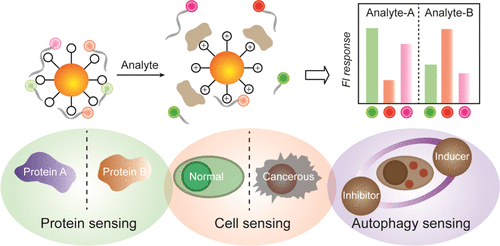Our official English website, www.x-mol.net, welcomes your
feedback! (Note: you will need to create a separate account there.)
Multichannel DNA Sensor Array Fingerprints Cell States and Identifies Pharmacological Effectors of Catabolic Processes.
ACS Sensors ( IF 8.2 ) Pub Date : 2019-12-10 , DOI: 10.1021/acssensors.9b01009 Nilanjana Das Saha , Ranjan Sasmal , Shafeekh Kulathinte Meethal , Somya Vats , Preethi V Gopinathan , Oishika Jash , Ravi Manjithaya , Nathalie Gagey-Eilstein 1 , Sarit S Agasti
ACS Sensors ( IF 8.2 ) Pub Date : 2019-12-10 , DOI: 10.1021/acssensors.9b01009 Nilanjana Das Saha , Ranjan Sasmal , Shafeekh Kulathinte Meethal , Somya Vats , Preethi V Gopinathan , Oishika Jash , Ravi Manjithaya , Nathalie Gagey-Eilstein 1 , Sarit S Agasti
Affiliation

|
Cells at disease onset are often associated with subtle changes in the expression level of a single or few molecular components, making traditionally used biomarker-driven clinical diagnosis a challenging task. We demonstrate here the design of a DNA nanosensor array with multichannel output that identifies the normal or pathological state of a cell based on the alteration of its global proteomic signature. Fluorophore-encoded single-stranded DNA (ssDNA) strands were coupled via supramolecular interaction with a surface-functionalized gold nanoparticle quencher to generate this integrated sensor array. In this design, ssDNA sequences exhibit dual roles, where they provide differential affinities with the receptor gold nanoparticle as well as act as transducer elements. The unique interaction mode of the analyte molecules disrupts the noncovalent supramolecular complexation, generating simultaneous multichannel fluorescence output to enable signature-based analyte identification via a linear discriminant analysis-based machine learning algorithm. Different cell types, particularly normal and cancerous cells, were effectively distinguished using their fluorescent fingerprints. Additionally, this DNA sensor array displayed excellent sensitivity to identify cellular alterations associated with chemical modulation of catabolic processes. Importantly, pharmacological effectors, which could modulate autophagic flux, have been effectively distinguished by generating responses from their global protein signatures. Taken together, these studies demonstrate that our multichannel DNA nanosensor is well suited for rapid identification of subtle changes in a complex mixture and thus can be readily expanded for point-of-care clinical diagnosis, high-throughput drug screening, or predicting the therapeutic outcome from a limited sample volume.
中文翻译:

多通道DNA传感器阵列指纹识别细胞状态并识别分解代谢过程的药理效应物。
疾病发作时的细胞通常与单个或几个分子成分表达水平的细微变化有关,这使得传统上使用生物标志物驱动的临床诊断成为一项艰巨的任务。我们在这里展示了具有多通道输出的DNA纳米传感器阵列的设计,该阵列基于其整体蛋白质组学特征的变化来识别细胞的正常或病理状态。荧光团编码的单链DNA(ssDNA)链通过超分子相互作用与表面功能化的金纳米粒子淬灭剂偶联,以生成此集成的传感器阵列。在这种设计中,ssDNA序列发挥双重作用,在其中它们与受体金纳米颗粒具有不同的亲和力,并充当换能器元件。分析物分子的独特相互作用模式破坏了非共价超分子络合物,同时产生了多通道荧光输出,从而可以通过基于线性判别分析的机器学习算法实现基于特征的分析物鉴定。使用它们的荧光指纹可以有效地区分不同的细胞类型,特别是正常和癌细胞。此外,这种DNA传感器阵列显示出出色的灵敏度,可以识别与分解代谢过程的化学调节有关的细胞改变。重要的是,可以调节自噬通量的药理效应子已经通过从其整体蛋白特征产生响应而得到有效区分。在一起
更新日期:2019-12-11
中文翻译:

多通道DNA传感器阵列指纹识别细胞状态并识别分解代谢过程的药理效应物。
疾病发作时的细胞通常与单个或几个分子成分表达水平的细微变化有关,这使得传统上使用生物标志物驱动的临床诊断成为一项艰巨的任务。我们在这里展示了具有多通道输出的DNA纳米传感器阵列的设计,该阵列基于其整体蛋白质组学特征的变化来识别细胞的正常或病理状态。荧光团编码的单链DNA(ssDNA)链通过超分子相互作用与表面功能化的金纳米粒子淬灭剂偶联,以生成此集成的传感器阵列。在这种设计中,ssDNA序列发挥双重作用,在其中它们与受体金纳米颗粒具有不同的亲和力,并充当换能器元件。分析物分子的独特相互作用模式破坏了非共价超分子络合物,同时产生了多通道荧光输出,从而可以通过基于线性判别分析的机器学习算法实现基于特征的分析物鉴定。使用它们的荧光指纹可以有效地区分不同的细胞类型,特别是正常和癌细胞。此外,这种DNA传感器阵列显示出出色的灵敏度,可以识别与分解代谢过程的化学调节有关的细胞改变。重要的是,可以调节自噬通量的药理效应子已经通过从其整体蛋白特征产生响应而得到有效区分。在一起











































 京公网安备 11010802027423号
京公网安备 11010802027423号